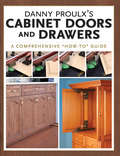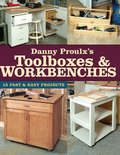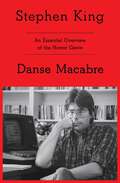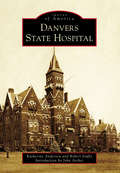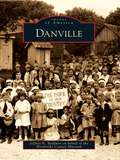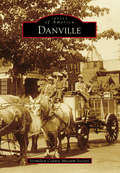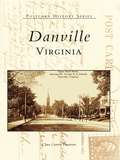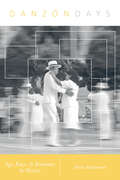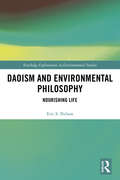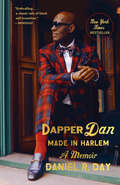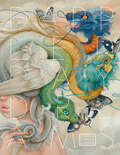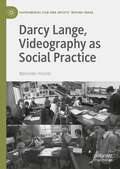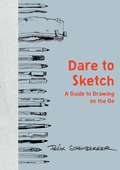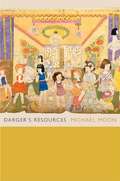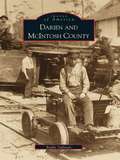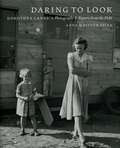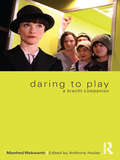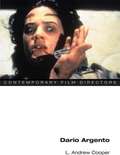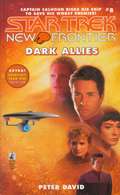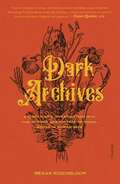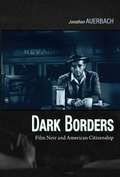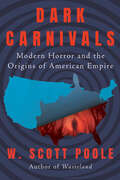- Table View
- List View
Danny Proulx's Cabinet Doors and Drawers
by Danny ProulxBuild Your Own Cabinet Doors and Drawers! With the authoritative advice and easy-to-follow instructions of expert cabinetmaker Danny Proulx, you will be able to make any style of cabinet door and drawer to fit your specific needs and wants. Danny Proulx's Cabinet Doors and Drawers provides the basics of joinery and joint terminology, explanations of door and drawer hardware, tons of helpful shop tips, plus eight chapters devoted to every type of door and drawer imaginable, including: Slab doors Frame and flat panel doors Raised panel doors Cope and stick doors Glass door frames Pocket, flipper and tambour doors Cabinet drawers Inlay door and drawer faces
Danny Proulx's Toolboxes & Workbenches: 13 Fast & Easy Projects
by Danny ProulxBuild toolboxes and workbenches tailored to suit your needs!Why spend countless hours and valuable dollars searching for storage solutions to fit your unique space, needs and wants? Now you can build the perfect toolbox and workbench to meet your specific requirements. Master craftsman Danny Proulx shows you how!Inside Danny Proulx's Toolboxes & Workbenches, you'll find clear, concise instructions and step-by-step photos for creating 13 solid, inexpensive projects. Proulx also provides expert advice and tips on making your workspace safer and cleaner.Make woodworking easier, more efficient and more fun with the toolboxes and workbenches of your dreams!Includes 13 easy projects to fit a variety of spaces and uses:Toolbox toteSimple workbenchFold-away work centerRolling tool cabinetTall storage cabinetsSimple sawhorsesRolling shop cartHand tool wall cabinetBase cabinet work centerCarpenter's toolboxCarver's tool chestMobile tool chestAdjustable worktable
Danse Macabre
by Stephen KingBefore he gave us the &“one of a kind classic&” (The Wall Street Journal) memoir On Writing, Stephen King wrote a nonfiction masterpiece in Danse Macabre, &“one of the best books on American popular culture&” (Philadelphia Inquirer).From the author of dozens of #1 New York Times bestsellers and the creator of many unforgettable movies comes a vivid, intelligent, and nostalgic journey through three decades of horror as experienced through the eyes of the most popular writer in the genre. In 1981, years before he sat down to tackle On Writing, Stephen King decided to address the topic of what makes horror horrifying and what makes terror terrifying. Here, in ten brilliantly written chapters, King delivers one colorful observation after another about the great stories, books, and films that comprise the horror genre—from Frankenstein and Dracula to The Exorcist, The Twilight Zone, and Earth vs. The Flying Saucers. With the insight and good humor his fans appreciated in On Writing, Danse Macabre is an enjoyably entertaining tour through Stephen King&’s beloved world of horror.
Danvers State Hospital (Images of America)
by Robert Duffy John Archer Katherine AndersonPerched high on the top of Hathorne Hill in what was once the village of Salem, Danvers State Insane Asylum was, for more than a century, a monument to modern psychiatry and the myriad advances in mental health treatment. From the time it opened its doors in 1878 until they were shuttered for good in 1992, the asylum represented decades of reform, the physical embodiment of the heroic visions of Dorothea Dix and Thomas Story Kirkbride. It would stand abandoned until 2005, when demolition began. Along with a dedicated group of private citizens, the Danvers Historical Society fought to preserve the Kirkbride structure, an effort that would result in the reuse of the administration building and two additional wings. Danvers has earned a unique place in history; the shell of the original Kirkbride building still stands overlooking the town. Though it has been changed drastically, the asylum's story continues as do efforts to memorialize it.
Danville
by Hendricks County Historical Museum Jeffrey K. BaldwinDanville, created in 1824 as the county seat of Hendricks County, was the hub of government, commerce, and agriculture. Farmers sold their crops in town and shopped there. As the agricultural economy diminished, Danville became home to workers commuting to Indianapolis. Danville residents have always valued education. On May 10, 1878, at the instigation of Prof. W. F. Harper of the Central Normal School of Ladoga, 50 farm wagons from Danville arrived at Ladoga and stole the whole school, including equipment, students, faculty, and baggage. Central Normal College was then installed in the facility previously housing the Hendricks County Seminary and the Danville Academy. From 1878 to 1951, Central Normal College was a Danville institution, turning out more than 75,000 graduates destined for leadership roles in education, business, law, and politics.
Danville (Images of America)
by Vermilion County Museum SocietyNamed after early pioneer and fur trapper Dan Beckwith, Danville was a dream realized when the first town lots were auctioned on April 10, 1827. The town grew, especially after the "iron horse" made its way into the area. The railroad opened the doors to Danville's rich manufacturing potential, and the town expanded. Serving as the Vermilion County seat, Danville has undergone many changes in the last 70 years. Although the focus of its economy has changed, the days of General Motors, Chuckles, General Electric, and many more businesses and industries that provided work and brought people to the county linger in memory. Employment provided a rich and full life upon which the heritage of Danville was built.
Danville, Virginia (Postcard History)
by Clara Garrett FountainSince its incorporation in 1833, Danville has proved one of the Old Dominion State's most interesting and historic cities, ranging from its brief stint as the last capital during the waning hours of the Confederacy, to its role as a major tobacco and textile producer in the late nineteenth and early twentieth centuries, to the city's infamous disasters, such as the wreck of the Old 97. In these images, readers will journey back into the Danville of yesteryear and explore many elements of the city's past: its historic churches along Main Street, its stunning Victorian and Edwardian architectural treasures along Millionaires Row, and many of the city's most recognizable structures, including schools, businesses, and early government buildings.
Danzón Days: Age, Race, and Romance in Mexico (Music in American Life)
by Hettie MalcomsonOlder people negotiating dance routines, intimacy, and racialized differences provide a focal point for an ethnography of danzón in Veracruz, the Mexican city closely associated with the music-dance genre. Hettie Malcomson draws upon on-site research with semi-professional musicians and amateur dancers to reveal how danzón connects, and does not connect, to blackness, joyousness, nostalgia, ageing, and romance. Challenging pervasive utopian views of danzón, Malcomson uses the idea of ambivalence to explore the frictions and opportunities created by seemingly contrary sentiments, ideas, sensations, and impulses. Interspersed with experimental ethnographic vignettes, her account takes readers into black and mestizo elements of local identity in Veracruz, nostalgic and newer styles of music and dance, and the friendships, romances, and rivalries at the heart of regular danzón performance and its complex social world. Fine-grained and evocative, Danzón Days journeys to one of the genre’s essential cities to provide new perspectives on aging and romance and new explorations of nostalgia and ambivalence.
Daoism and Environmental Philosophy: Nourishing Life (Routledge Explorations in Environmental Studies)
by Eric S. NelsonDaoism and Environmental Philosophy explores ethics and the philosophy of nature in the Daodejing, the Zhuangzi, and related texts to elucidate their potential significance in our contemporary environmental crisis. This book traces early Daoist depictions of practices of embodied emptying and forgetting and communicative strategies of undoing the fixations of words, things, and the embodied self. These are aspects of an ethics of embracing plainness and simplicity, nourishing the asymmetrically differentiated yet shared elemental body of life of the myriad things, and being responsively attuned in encountering and responding to things. These critical and transformative dimensions of early Daoism provide exemplary models and insights for cultivating a more expansive ecological ethos, environmental culture of nature, and progressive political ecology. This work will be of interest to students and scholars interested in philosophy, environmental ethics and philosophy, religious studies, and intellectual history.
Dapper Dan: A Memoir
by Daniel DayWith his now-legendary store on 125th Street in Harlem, Dapper Dan pioneered high-end streetwear in the 1980s, remixing classic luxury-brand logos into his own innovative, glamorous designs. But before he reinvented haute couture, he was a hungry boy with holes in his shoes, a teen who daringly gambled drug dealers out of their money, and a young man in a prison cell who found nourishment in books. In this remarkable memoir, he tells his full story for the first time. <p><p> Decade after decade, Dapper Dan discovered creative ways to flourish in a country designed to privilege certain Americans over others. He witnessed, profited from, and despised the rise of two drug epidemics. He invented stunningly bold credit card frauds that took him around the world. He paid neighborhood kids to jog with him in an effort to keep them out of the drug game. And when he turned his attention to fashion, he did so with the energy and curiosity with which he approaches all things: learning how to treat fur himself when no one would sell finished fur coats to a Black man; finding the best dressed hustler in the neighborhood and converting him into a customer; staying open twenty-four hours a day for nine years straight to meet demand; and, finally, emerging as a world-famous designer whose looks went on to define an era, dressing cultural icons including Eric B. and Rakim, Salt-N-Pepa, Big Daddy Kane, Mike Tyson, Alpo Martinez, LL Cool J, Jam Master Jay, Diddy, Naomi Campbell, and Jay-Z. <p> By turns playful, poignant, thrilling, and inspiring, Dapper Dan: Made in Harlem is a high-stakes coming-of-age story spanning more than seventy years and set against the backdrop of an America where, as in the life of its narrator, the only constant is change. <P><b>A New York Times Bestseller</b>
Dappled Daydreams: The Art of Camilla d'Errico
by Camilla d'ErricoThe breathtaking figures of Camilla d'Errico return in a new hardcover volume! Magnetic and surreal, d'Errico's arresting subjects, their piercing eyes and dynamic colors, are often juxtaposed with the cute, creepy, bizarre, and the otherworldly.This collection features d'Errico's recent artwork, including pieces from her sensational gallery shows "Submerged," "Sky," and "Zodiac." An accomplished painter, illustrator, and comic book artist as well as designer of custom toys, clothing, accessories, and more, d'Errico showcases her perpetually stunning pop surrealist style in all its glory.
Darcy Lange, Videography as Social Practice (Experimental Film and Artists’ Moving Image)
by Mercedes VicenteThe Videography of Darcy Lange is a critical monograph of a pivotal figure in early analogue video. Trained as a sculptor at the Royal College of Art, Lange developed a socially engaged video practice with remarkable studies of people at work in industrial, farming, and teaching contexts that drew from conceptual art, social documentary and structuralist filmmaking. Lange saw in portable video a democratic tool for communication and social transformation, continuing the legacy of the revolutionary avant-garde projects that merged art with social life and turned audiences into producers. This book follows Lange's trajectory from his early observational studies to the crisis of representation and socially engaged video and activism, as it is shaped by, and resists, the artistic, cultural and political preoccupations of the 1970s and 1980s. It strikes a balance between being a monographic account providing a close analysis of Lange's oeuvre and drawing from unpublished archival materials—a sort of catalogue raisonné—whilst maintaining a breadth with theoretical discourses around the themes of labour and class, education, and indigenous struggles central to his work. The book's frameworks of Conceptual Art, structuralist and ethnographic film theory, social documentary and the critique of representation, video as social practice and the notion of 'feedback', participatory socially engaged art and postcolonial and indigenous theory,—expand our understanding of video outside the predominant structuralist tendencies. Lange's transnational and nomadic career introduces notions of alterity and challenges nationalistic accounts that excluded him in the past.
Dare to Sketch: A Guide to Drawing on the Go
by Felix ScheinbergerAn inspirational, instructional, and visually stimulating guide to sketching and drawing. Dare to Sketch is filled with practical tips about which materials to use, a variety of subject matter ranging from easy to more challenging, and wisdom about overcoming creative blocks and fear of making mistakes. A whimsical beginner's guide to sketching, covering all of the important basics: what kind of notebook to buy, what drawing materials to use, ideas for subject matter, and daily exercises. Includes inviting, inspirational, and idiosyncratic tips (don't start on the first page of your sketchbook!), Dare to Sketch is gorgeously illustrated with the author's unique and contemporary art style.
Darger’s Resources
by Michael MoonHenry Darger (1892-1973) was a hospital janitor and an immensely productive artist and writer. In the first decades of adulthood, he wrote a 15,145-page fictional epic, In the Realms of the Unreal. He spent much of the rest of his long life illustrating it in astonishing drawings and watercolors. In Darger's unfolding saga, pastoral utopias are repeatedly savaged by extreme violence directed at children, particularly girls. Given his disturbing subject matter and the extreme solitude he maintained throughout his life, critics have characterized Darger as eccentric, deranged, and even dangerous, as an outsider artist compelled to create a fantasy universe. Contesting such pathologizing interpretations, Michael Moon looks to Darger's resources, to the narratives and materials that inspired him and often found their way into his writing, drawings, and paintings. Moon finds an artist who reveled in the burgeoning popular culture of the early twentieth century, in its newspaper comic strips, pulp fiction, illustrated children's books, and mass-produced religious art. Moon contends that Darger's work deserves and rewards comparison with that of contemporaries of his, such as the "pulp historians" H. P. Lovecraft and Robert Howard, the Oz chronicler L. Frank Baum, and the newspaper cartoonist Bud Fisher.
Darien and McIntosh County
by Buddy SullivanFrom 1870 to 1920, McIntosh County, Georgia, was one of the most energetic communities on the southern coast. Its county seat, Darien, never had a population of more than 2,000 residents; yet, little Darien was, for a considerable time, the leading exporter of yellow pitch pine timber on theAtlantic Coast. Burned to ashes during the Civil War, Darienrose up and, with its timber booms and sawmills, took its place among the leading towns of the "New South" of the late nineteenth century. In this unique photographic retrospective of Darien and McIntosh County, over 200 images evoke generations past of dynamic, hard-working people. Pictured within these pages are timber barons, sawmill workers, railroad builders, and shrimp fishermen. They are depicted among views of the buildings and structures associated with an era that was the most active in the recorded history of the community, which dates back to the earliest days of the Georgia colony in 1736.
Daring to Look: Dorothea Lange’s Photographs and Reports from the Field
by Anne Whiston SpirnNear the end of her career, Dorothea Lange lamented, "No country has ever closely scrutinized itself visually... I know what we could make of it if people only thought we could dare look at ourselves." Lange, however, did look, unflinchingly turning her lens on the despair, degradation, and greed unleashed by the Great Depression, and her photographs for the New Deal's Farm Security Administration have become the defining images of that time, capturing a country and a people on the brink of cataclysmic change. But the iconic images we all know don't come close to telling the whole story. Lange viewed her photographs as part of sequenced narratives, contextualized and enriched by her descriptive captions-- without which, she wrote, "half the value of fieldwork is lost." Daring to Look presents never-before-published photos and captions from Lange's fieldwork in California, the Pacific Northwest, and North Carolina during 1939. Lange's images of squatter camps, benighted farmers, and stark landscapes are stunning, and her captions-- which range from simple explanations of settings to historical notes and biographical sketches--add unexpected depth, bringing her subjects and their struggles unforgettably to life, often in their own words. When Lange was dismissed from the Farm Security Administration at the end of 1939, these photos and field notes were consigned to archives, where they languished, rarely seen. With Daring to Look, Anne Whiston Spirn not only returns them to the public eye, but sets them in the context of Lange's pioneering life, work, and struggle for critical recognition-- firmly placing Lange in her rightful position at the forefront of American photography.
Daring to Play: A Brecht Companion
by Manfred WekwerthTranslated into English for the first time, Daring To Play: A Brecht Companion is the study of Bertolt Brecht’s theatre by Manfred Wekwerth, Brecht’s co-director and former director of the Berliner Ensemble. Wekwerth aims to challenge prevailing myths and misconceptions of Brecht’s theatre, instead providing a refreshing and accessible approach to his plays and theatrical craft. The book is rich in information, examples and anecdotal detail from first-hand acquaintance with Brecht and rehearsal with the Berliner Ensemble. Wekwerth provides a detailed practical understanding of how theatre operates with a clear perspective on the interface between politics and art. Warm and engaging, whilst also being provocative and challenging, Daring to Play displays the continued vitality of Brecht’s true approach to theatre makers today.
Dario Argento (Contemporary Film Directors)
by L. Andrew CooperCommanding a cult following among horror fans, Italian film director Dario Argento is best known for his work in two closely related genres, the crime thriller and supernatural horror, as well as his influence on modern horror and slasher movies. In his four decades of filmmaking, Argento has displayed a commitment to innovation, from his directorial debut with 1970's suspense thriller The Bird with the Crystal Plumage to 2009's Giallo. His films, like the lurid yellow-covered murder-mystery novels they are inspired by, follow the suspense tradition of hard-boiled American detective fiction while incorporating baroque scenes of violence and excess. While considerations of Argento's films often describe them as irrational nightmares, L. Andrew Cooper uses controversies and theories about the films' reflections on sadism, gender, sexuality, psychoanalysis, aestheticism, and genre to declare the anti-rational logic of Argento's oeuvre. Approaching the films as rhetorical statements made through extremes of sound and vision, Cooper places Argento in a tradition of aestheticized horror that includes De Sade, De Quincey, Poe, and Hitchcock. Analyzing individual images and sequences as well as larger narrative structures, he reveals how the director's stylistic excesses, often condemned for glorifying misogyny and other forms of violence, offer productive resistance to the cinema's visual, narrative, and political norms.
Dark Allies (Star Trek #8)
by Peter DavidMany years ago, a bizarre alien lifeform known as the Black Mass consumed and destroyed an entire solar system in what was then the Thallonian Empire. Now the Black Mass has returned and its target is Tulan IV, homeworld of the fearsome Redeemers. Faced with near-certain destruction, the Overlord of the Redeemers is forced to turn to an unlikely ally: Captain Mackenzie Calhoun and the Starship Excalibur. Busy coping with the return of his rebellious son, Calhoun is none too eager to come to the aid of his despotic enemy; but when innocent lives are at stake he has no choice but to confront the implacable Black Mass. But how can one solitary Starship hope to turn back a force capable of consuming entire suns?
Dark Archives: A Librarian's Investigation into the Science and History of Books Bound in Human Skin
by Megan RosenbloomOn bookshelves around the world, surrounded by ordinary books bound in paper and leather, rest other volumes of a distinctly strange and grisly sort: those bound in human skin. Would you know one if you held it in your hand?In Dark Archives, Megan Rosenbloom seeks out the historic and scientific truths behind anthropodermic bibliopegy—the practice of binding books in this most intimate covering. Dozens of such books live on in the world’s most famous libraries and museums. Dark Archives exhumes their origins and brings to life the doctors, murderers, innocents, and indigents whose lives are sewn together in this disquieting collection. Along the way, Rosenbloom tells the story of how her team of scientists, curators, and librarians test rumored anthropodermic books, untangling the myths around their creation and reckoning with the ethics of their custodianship. A librarian and journalist, Rosenbloom is a member of The Order of the Good Death and a cofounder of their Death Salon, a community that encourages conversations, scholarship, and art about mortality and mourning. In Dark Archives—captivating and macabre in all the right ways—she has crafted a narrative that is equal parts detective work, academic intrigue, history, and medical curiosity: a book as rare and thrilling as its subject.
Dark Borders: Film Noir and American Citizenship
by Jonathan AuerbachDark Borders connects anxieties about citizenship and national belonging in midcentury America to the sense of alienation conveyed by American film noir. Jonathan Auerbach provides in-depth interpretations of more than a dozen of these dark crime thrillers, considering them in relation to U. S. national security measures enacted from the mid-1930s to the mid-1950s. The growth of a domestic intelligence-gathering apparatus before, during, and after the Second World War raised unsettling questions about who was American and who was not, and how to tell the difference. Auerbach shows how politics and aesthetics merge in these noirs, whose oft-noted uncanniness betrays the fear that "un-American" foes lurk within the homeland. This tone of dispossession was reflected in well-known films, including Double Indemnity, Out of the Past, and Pickup on South Street, and less familiar noirs such as Stranger on the Third Floor, The Chase, and Ride the Pink Horse. Whether tracing the consequences of the Gestapo in America, or the uncertain borderlines that separate the United States from Cuba and Mexico, these movies blur boundaries; inside and outside become confused as (presumed) foreigners take over domestic space. To feel like a stranger in your own home: this is the peculiar affective condition of citizenship intensified by wartime and Cold War security measures, as well as a primary mood driving many midcentury noir films.
Dark Carnival: The Secret World of Tod Browning, Hollywood’s Master of the Macabre
by David J. Skal Elias SavadaThe definitive biography of Hollywood horror legend Tod Browning—now revised and expanded with new material One of the most original and unsettling filmmakers of all time, Tod Browning (1880–1962) began his career buried alive in a carnival sideshow and saw his Hollywood reputation crash with the box office disaster–turned–cult classic Freaks. Penetrating the secret world of &“the Edgar Allan Poe of the cinema,&” Dark Carnival excavates the story of this complicated, fiercely private man. In this newly revised and expanded edition of their biography first published in 1995, David J. Skal and Elias Savada researched Browning&’s recently unearthed scrapbooks and photography archives to add further nuance and depth to their previous portrait of this enigmatic artist. Skal and Savada chronicle Browning&’s turn-of-the-century flight from an eccentric Louisville family into the realm of carnivals and vaudeville, his disastrous first marriage, his rapid climb to riches in the burgeoning silent film industry, and the alcoholism that would plague him throughout his life. They offer a close look at Browning&’s legendary collaborations with Lon Chaney and Bela Lugosi as well as the studio politics that brought his remarkable run to an inglorious conclusion. With a revised prologue, epilogue, filmography, and new text and illustrations throughout, Dark Carnival is an unparalleled account of a singular filmmaker and an illuminating depiction of the evolution of horror and the early film industry.
Dark Carnivals: Modern Horror and the Origins of American Empire
by W. Scott PooleThe panoramic story of how the horror genre transformed into one of the most incisive critiques of unchecked American imperial power The American empire emerged from the shadows of World War II. As the nation&’s influence swept the globe with near impunity, a host of evil forces followed—from racism, exploitation, and military invasion to killer clowns, flying saucers, and monsters borne of a fear of the other. By viewing American imperial history through the prism of the horror genre, Dark Carnivals lays bare how the genre shaped us, distracted us, and gave form to a violence as American as apple pie. A carnival ride that connects the mushroom clouds of 1945 to the beaches of Amity Island, Charles Manson to the massacre at My Lai, and John Wayne to John Wayne Gacy, the new book by acclaimed historian W. Scott Poole reveals how horror films and fictions have followed the course of America&’s military and cultural empire and explores how the shadow of our national sins can take on the form of mass entertainment.
Dark City Dames: The Women Who Defined Film Noir (Revised and Expanded Edition)
by Eddie MullerIn this revised and expanded edition of his essential volume Dark City Dames, Eddie Muller—Turner Classic Movies host and author of Dark Cityand Noir Bar—offers a uniquely intimate look at the women who defined film noir, now featuring updated text, photos, and 10 new star profiles. Film noir was the dark side of the movies&’ happily-ever-after mythology. Sinister and sexy, it forged a new icon: the tough, independent dame. Determined, desirable, dangerous when cornered, she could handle trouble—or deal out some of her own. If you thought these women were something special onscreen, wait until you meet the genuine articles. In Dark City Dames, acclaimed film historian Eddie Muller takes readers into the world of six women who made a lasting impression in this cinematic terrain—from veteran &“bad girls&” Audrey Totter, Marie Windsor, and Jane Greer to unexpected genre fixtures Evelyn Keyes, Coleen Gray, and Ann Savage. The book provides in-depth profiles of these formidable women during the height of their careers, circa 1950, as they balanced love and career, struggled against typecasting, and sought fulfillment in a ruthless business. Their personal stories—teeming with larger-than-life characters like Howard Hughes, Louis B. Mayer, Robert Mitchum, Otto Preminger, and John Huston—offer a fascinating counterpoint to their movies. Then Dark City Dames revisits each woman fifty years later, to witness their hard-won—and triumphant—survival. On every page their own voices ring through, reflecting on their lives with as much passion, pain, intelligence, energy, and humor as any movie script. Muller conducted far-ranging interviews with the original six women profiled in Dark City Dames, in the process becoming a friend and confidante to each. In this revised and expanded edition, he updates their stories and shares illuminating, never-before-told memories of his time with them. This edition also includes compelling new profiles of ten additional women who left an indelible mark on film noir, including Joan Bennett, Gail Russell, Rhonda Fleming, and Claire Trevor—all packaged in a stunning redesign that offers the ultimate look at performers who helped define a still-resonant and inspiring epoch of Hollywood history.
Dark City: The Lost World of Film Noir (Revised and Expanded Edition) (Turner Classic Movies)
by Eddie MullerThis revised and expanded edition of Eddie Muller's Dark City is a film noir lover's bible, taking readers on a tour of the urban landscape of the grim and gritty genre in a definitive, highly illustrated volume.Dark Cityexpands with new chapters and a fresh collection of restored photos that illustrate the mythic landscape of the imagination. It's a place where the men and women who created film noir often find themselves dangling from the same sinister heights as the silver-screen avatars to whom they gave life. Eddie Muller, host of Turner Classic Movies' Noir Alley, takes readers on a spellbinding trip through treacherous terrain: Hollywood in the post-World War II years, where art, politics, scandal, style -- and brilliant craftsmanship -- produced a new approach to moviemaking, and a new type of cultural mythology.
